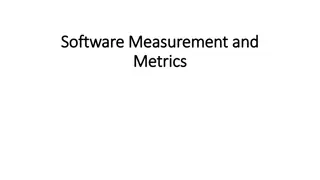Software Process Models: A Comparative Analysis
Explore the differences between prescriptive and evolutionary software process models, such as the Waterfall Model and Incremental Model. Delve into the challenges and benefits of each approach, considering factors like adaptability, coordination, and efficiency in software development projects.
Download Presentation

Please find below an Image/Link to download the presentation.
The content on the website is provided AS IS for your information and personal use only. It may not be sold, licensed, or shared on other websites without obtaining consent from the author.If you encounter any issues during the download, it is possible that the publisher has removed the file from their server.
You are allowed to download the files provided on this website for personal or commercial use, subject to the condition that they are used lawfully. All files are the property of their respective owners.
The content on the website is provided AS IS for your information and personal use only. It may not be sold, licensed, or shared on other websites without obtaining consent from the author.
E N D
Presentation Transcript
Chapter 4 Process Models: Prescriptive Models vs. Evolutionary Models Moonzoo Kim KAIST 1
Prescriptive Models Prescriptive process models advocate an orderly approach to software engineering That leads to a few questions If prescriptive process models strive for structure and order, are they inappropriate for a software world that thrives on change? Yet, if we reject traditional process models (and the order they imply) and replace them with something less structured, do we make it impossible to achieve coordination and coherence in software work? 2
The Waterfall Model (1/2) Communication project init iat ion requirement gat hering Planning estimating scheduling tracking Modeling analysis design Construction code test Deployment delivery support f eedback Which problems does the waterfall model have? Real projects rarely follow the sequential flow Difficult to accommodating the uncertainty in requirements A working version of SW will not be available until late in the project 1. 2. 3. 3
The Waterfall Model (2/2) Communication project init iat ion requirement gat hering Planning estimating scheduling tracking Modeling analysis design Construction code test Deployment delivery support f eedback Bradac[BRA94] found that the linear nature of the waterfall model leads to blocking states Where some members must wait for other members of the team to complete dependent tasks Especially, at the beginning of the project Still, however, the waterfall model serve as a useful process model where requirements are fixed and work is to proceed to completion in a linear manner 4
The Incremental Model increment # n C o m m u n i c a t i o n P l a n n i n g M o d e l i n g analysis design C o n s t r u c t i o n Can manage technical risks code t est D e p l o y m e n t d e l i v e r y f e e d b a c k delivery of nt h increment increment # 2 C o m m u n i c a t i o n P l a n n i n g M o d e l i n g analysis design C o n s t r u c t i o n code t est D e p l o y m e n t d e l i v e r y f e e d b a c k delivery of 2nd increment increment # 1 C o m m u n i c a t i o n P l a n n i n g M o d e l i n g analysis design C o n s t r u c t i o n code t est Can be implemented with fewer people delivery of 1st increment D e p l o y m e n t d e l i v e r y f e e d b a c k project calendar time 5
The RAD (Rapid Application Development) Model Team # n Mo d e lin g business modeling data modeling process modeling Co n st ru ct io n component reuse automatic code generation testing Team # 2 Communication Modeling business modeling dat a modeling process modeling Planning Deployment int egrat ion delivery feedback Construction component reuse aut omat ic code generat ion t est ing Team # 1 Modeling business modeling dat a modeling process modeling Requires sufficient human resources Modularization is prerequisite Global tuning is not possible Construction component reuse aut omat ic code generat ion t est ing 60 - 90 days 6
Evolutionary Models: The Spiral planning estimation scheduling risk analysis communication modeling analysis design start deployment delivery feedback construction code test 7
Evolutionary Models: Prototyping (1/2) A prototyping paradigm is the best-fit for the following situations A customer does not identify detailed requirements for SW SW engineers are not sure of the efficiency of an algorithm, usability of SW, and so on. In other words, prototyping paradigm helps SW engineers and the customers to understand what is to be built The quick design and implementation focuses on a representation of those aspects of the SW that will be visible to the customer Ideally, the prototype serves as a mechanism for identifying SW requirements
Evolutionary Models: Prototyping (2/2) Some problems in prototyping paradigm SW engineers try to modify the prototype to use as a working version Once the customer see the working prototype, he/she expects to get working product soon Quick plan Quick plan Communication communication Modeling Modeling Quick design Quick design Deployment Deployment delivery & Delivery & Feedback feedback Construction of prototype of prototype Construction 9
Still Other Process Models Component based development the process to apply when reuse is a development objective Formal methods emphasizes the mathematical specification of requirements Aspect Oriented SW Development (ASOP) provides a process and methodological approach for defining, specifying, designing, and constructing aspects Unified Process a use-case driven, architecture-centric, iterative and incremental software process closely aligned with the Unified Modeling Language (UML) 10
Quick Overview of SafeHome The SafeHome company has developed an innovative HW box that implements wireless Internet (802.11) connectivity in a very small form factor (the size of a matchbook). The idea is to use this technology to develop and market a comprehensive home automation product line. This would provide security functions control over telephone answering machines lights heating air conditioning home entertainment devices. The first generation of the system will only focus on home security since that is a market the public readily understands. 11
Selecting a Process Model, Part 1(pg 85-86) Doug: Seems like we've been pretty disorganized in our approach to software in the past. Ed: I don't know, Doug. We always got product out the door. Doug: True, but not without a lot of grief, and this project looks like it's bigger and more complex than anything we've done in the past. Jamie: Doesn't look that hard, but I agree ... our ad hoc approach to past projects won't work here, particularly if we have a very tight timeline. Doug (smiling): I want to be a bit more professional in our approach. I went to a short course last week and learned a lot about software engineering ... good stuff. We need a process here. The scene: Meeting room for the software engineering group at CPI Corporation, a (fictional) company that makes consumer products for home and commercial use. The players: Lee Warren, engineering manager; Doug Miller, software engineering manager; Jamie Lazar, software team member; Vinod Raman, software team member; Ed Robbins, software team member. The conversation: Lee: So let's recapitulate. I've spent some time discussing the SafeHome product line as we see it at the moment. No doubt, we've got a lot of work to do to simply define the thing, but I'd like you guys to begin thinking about how you're going to approach the software part of this project. CS350 Intro. to SE Spring 2008 12
Jamie (with a frown): My job is to build computer programs, not push paper around Doug: Give it a chance before you go negative on me. Here's what I mean. [Doug proceeds to describe the process framework described in Chapter 2 and the prescriptive process models presented to this point] Doug: So anyway, it seems to me that a linear model is not for us ... assumes we have all requirements up front and knowing this place, that's not likely. Vinod: Yeah, and that RAD model sounds way too IT- oriented ... probably good for building an inventory control system or something, but it's just not right for SafeHome Doug: I agree. Ed: That prototyping approach seems OK. A lot like what we do here anyway. Vinod: That's a problem. I'm worried that it doesn't provide us with enough structure. Doug: Not to worry. We've got plenty of other options, and I want you guys to pick what's best for the team and best for the project. CS350 Intro. to SE Spring 2008 13
Selecting a Process Model, Part 2 (pg90-91) The players: Lee Warren: engineering manager Doug Miller: SE manager Ed and Vinod: members of the SE team The conversation: (Doug describes evolutionary process options) Ed: Now I see something I like. An incremental approach makes sense and I really like the flow of that spiral model thing. That s keeping it real. Vinod: I agree. We deliver an increment, learn from customer feedback, replan, and then deliver another increment. It also fits into the nature of the product. We can have something on the market fast and then add functionality with each version, er, increment. Lee: Wait a minute, did you say that we regenerate the plan with each tour around the spiral, Doug? That s not so great, we need one plan, one schedule, and we ve got to stick to it. Doug: That s old school thinking, Lee. Like Ed said, we ve got to keep it real. I submit that it s better to tweak the plan as we learn more and as changes are requested. It s way more realistic. What s the point of a plan if it doesn t reflect reality? Lee (frowning): I suppose so, but senior management s not going to like this they want a fixed plan. Doug (smiling): Then, you ll have to reeducate them, buddy 14























